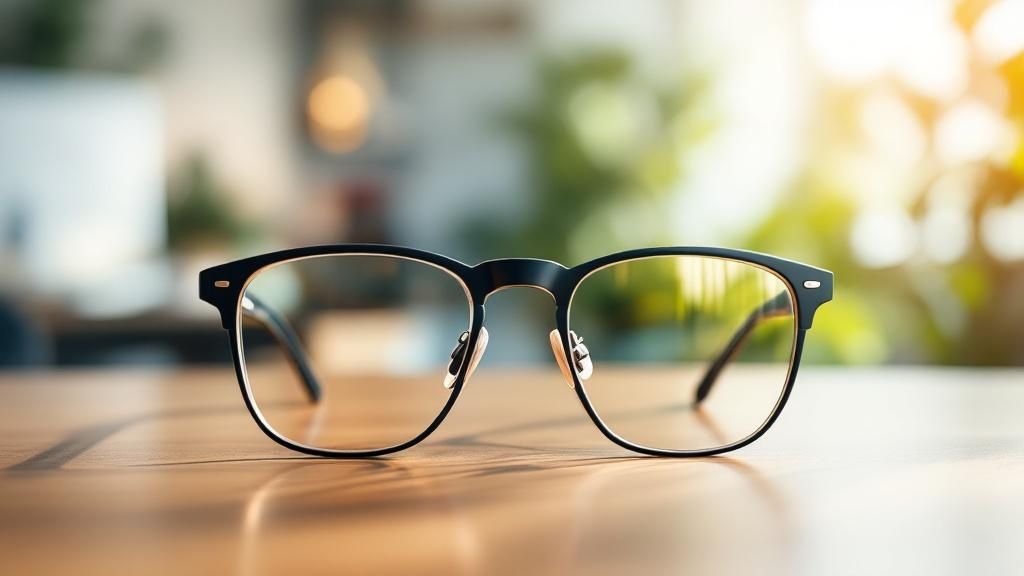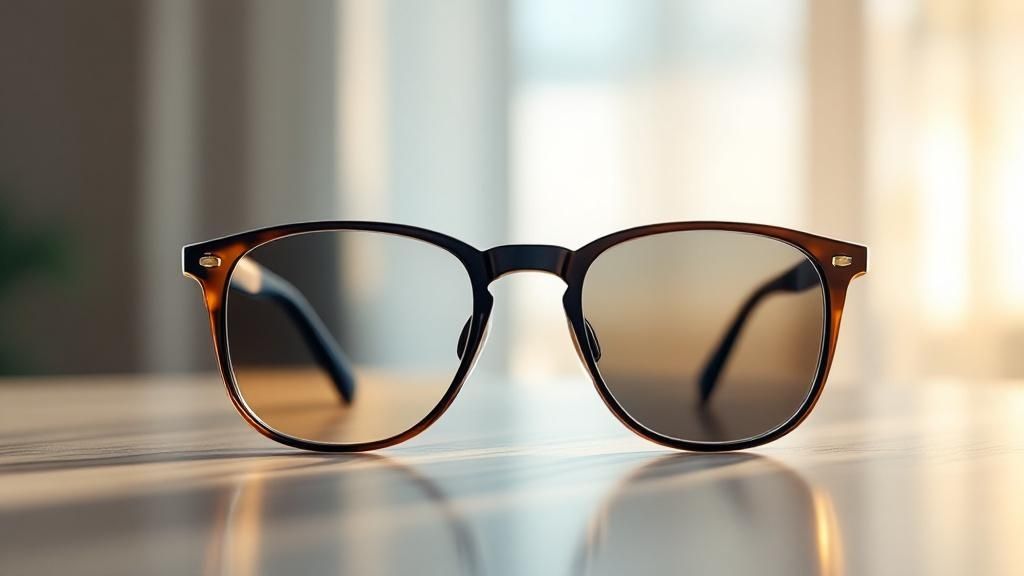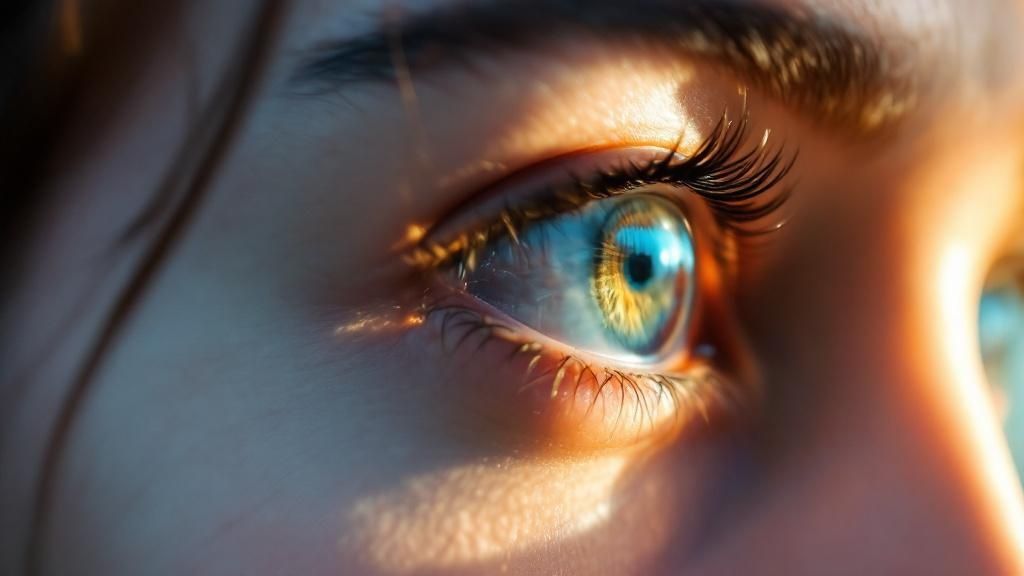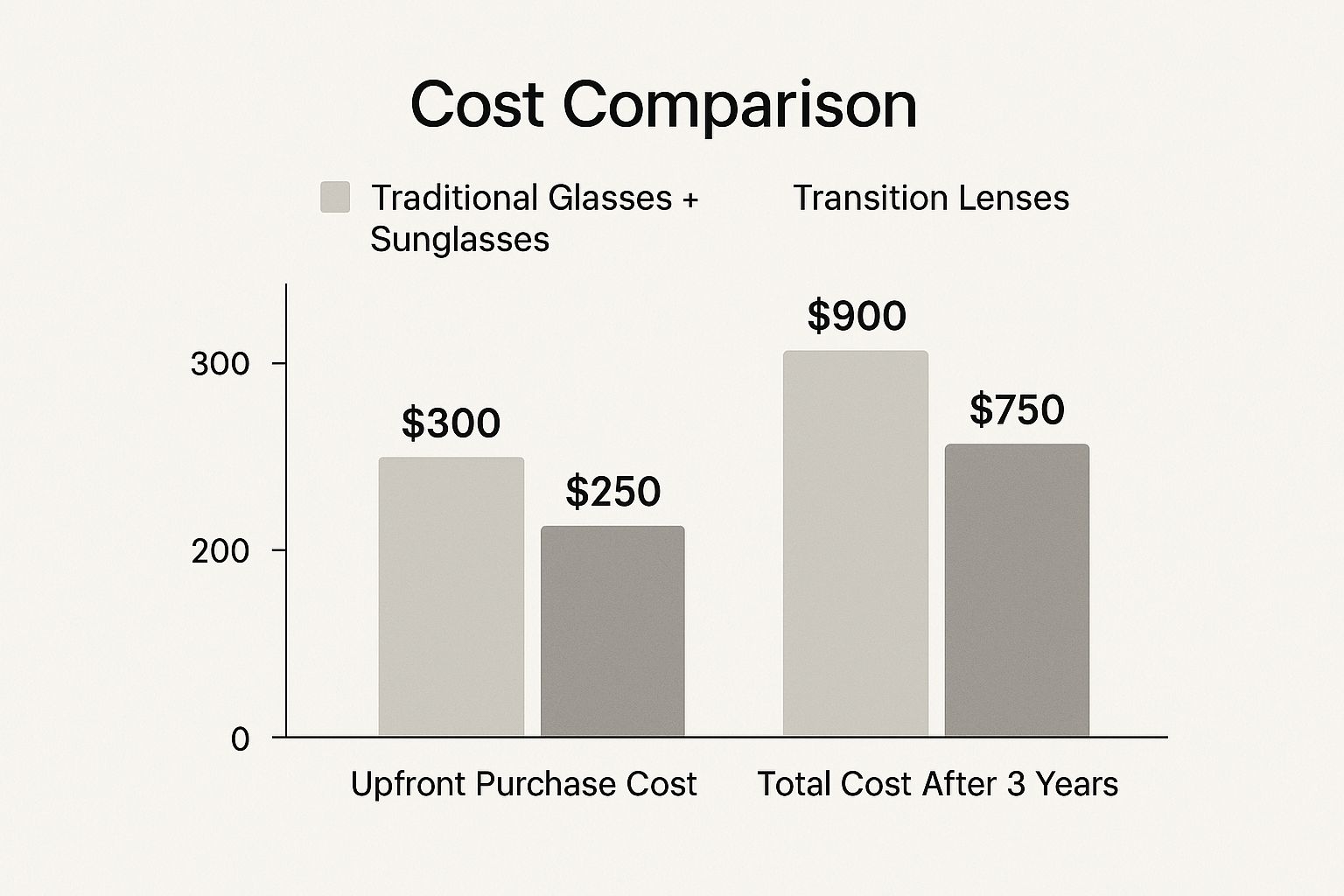
Transition Lenses Benefits: Discover Clearer, Comfortable Vision
Have you ever wished your glasses could just know when you need them to be sunglasses? That's pretty much the brilliant idea behind transition lenses. They offer automatic, on-the-fly adaptation to light, giving you constant comfort and protection without a second thought. This smart technology is where all the key benefits of transition lenses come from, combining pure convenience with features that are critical for your long-term eye health.
How Do Transition Lenses Actually Work?

The real magic behind these lenses is found in something called photochromic molecules. The best way to think about these is like millions of microscopic flowers embedded in your lenses. When you step outside into the sunlight, these molecules are exposed to UV rays and react by instantly "blooming" or changing their chemical structure.
This reaction is what causes the lenses to darken into a comfortable, sunglass-level tint. The more intense the sun, the more molecules spring into action, and the darker your glasses get. It’s a perfectly scaled response to your environment.
Returning to a Clear State
So, what happens when you head back inside? As soon as you're out of direct UV light, the trigger is gone. The photochromic molecules "close" back up, reverting to their original, transparent state. Within just a few minutes, your lenses will fade back to being completely clear.
The whole process is a seamless and silent chemical reaction that happens entirely on its own. You get the perfect amount of tint for any situation without ever having to switch glasses, ensuring your eyes always feel relaxed and comfortable.
This smart, adaptive functionality is catching on in a big way. The global market for transition lenses is expected to jump from $5 billion in 2025 to nearly $8 billion by 2033. That kind of growth shows a clear demand from people who want eyewear that delivers both effortless convenience and serious eye protection. You can see more details on these market trends over at DataInsightsMarket.com.
Once you grasp this simple mechanism, all the other benefits just click into place. That automatic darkening provides 100% UV protection and the adaptive tint means less squinting and eye fatigue. It’s a simple concept that has a massive impact on how you see the world every day.
The Power of Automatic UV Protection

Sure, the convenience is great, but the single biggest benefit of transition lenses is the constant, powerful shield they create for your eyes. This goes way beyond simply cutting down on glare; it’s about providing automatic and total protection from the sun's invisible threats.
High-quality photochromic lenses are specifically designed to block 100% of harmful UVA and UVB rays. This protection kicks in the second you step outside, giving you a reliable barrier that looks after your long-term eye health without you ever having to think about it.
Defending Against Long-Term Damage
This automatic defense is far more important than most people realize. Ongoing exposure to UV radiation is a major factor in serious eye conditions that can creep up over many years. We're talking about an increased risk for both cataracts, which cloud the eye's natural lens, and macular degeneration, a leading cause of vision loss.
By automatically adapting to UV light, transition lenses essentially act as a preventative tool. They take human error—like forgetting or misplacing your sunglasses—out of the equation, ensuring your eyes have a consistent defense against cumulative UV damage.
And this isn't just for bright, sunny days. Nasty UV rays can easily penetrate clouds and are still a threat on overcast days when you might not think you need protection. Understanding exactly how UV rays affect your eyes really hammers home why this built-in, always-on shield is so critical for daily life.
The lenses are basically on guard duty for you, offering a few key protective perks:
- Always-On UV Blocking: Protection is active anytime UV light is present, not just when you happen to remember your sunglasses.
- Reduced Risk: Helps lower your lifetime exposure to the radiation linked to serious eye diseases.
- All-Weather Safety: Guards your eyes on bright and cloudy days alike, when UV levels can be surprisingly high.
Ultimately, transition lenses do more than just change their tint. They give you real peace of mind, knowing your vision is constantly shielded from the sun’s most damaging effects.
Reducing Eye Strain and Enhancing Comfort
One of the best, most immediate benefits of wearing transition lenses is the huge improvement in your day-to-day visual comfort. If you've ever stepped outside and immediately started squinting, or felt that dull ache behind your eyes after a day in the sun, you know exactly what eye strain feels like. These lenses are designed to tackle that problem head-on.
By automatically adjusting their tint, they essentially work like a dimmer switch for your eyes. This constant, seamless adaptation means your pupils aren't getting blasted by sudden, harsh light, which drastically cuts down on the need to squint. It's a simple change that lets your eye muscles stay relaxed and prevents that feeling of fatigue.
A Smoother Visual Experience
Picture this: you're walking out of a dimly lit office building and straight into a bright, sunny afternoon. That sudden explosion of light is jarring, even a bit painful. With transition lenses, that sharp contrast is completely softened.
The lenses absorb that harsh glare before it even has a chance to hit your eyes, creating a much smoother and more pleasant visual experience. This automatic light regulation is a game-changer, especially for people who deal with light sensitivity, or photophobia.
This isn't just a perk for extreme situations; it's working all the time to make your everyday life more comfortable and even safer. Think about these common scenarios where cutting down on glare and strain really matters:
- Driving During the Day: They slash the blinding glare that reflects off other cars and wet roads, helping you see the road more clearly and react a bit faster.
- Outdoor Activities: Whether you're out for a walk, on a run, or just grabbing a coffee on a patio, the adaptive tint keeps your vision comfortable and sharp.
- Daily Errands: Popping in and out of stores no longer feels like a constant cycle of squinting and adjusting your eyes. The lenses simply do the work for you.
By actively managing the light that gets to your eyes, these lenses do a lot more than just provide shade. They're a practical tool for maintaining visual comfort and reducing the daily toll that bright environments can take. Taking these small steps to reduce strain is a key part of understanding how healthy are your eyes over the long haul.
The Convenience of All-in-One Eyewear
If you wear prescription glasses, you know the routine all too well. It’s the constant juggling act: carrying, swapping, and trying to keep track of a second pair of sunglasses. It's a small but persistent frustration, and it almost always ends with a misplaced or forgotten pair right when you need it.
This is where photochromic technology is a game-changer. It elegantly combines your precise vision correction with adaptive sun protection in a single, seamless package. No more fumbling for sunglasses when you step outside, and no more switching back to clear glasses when you head indoors. Your eyewear simply does the work for you.
A Smart and Cost-Effective Choice
Beyond just making your daily routine easier, choosing an all-in-one solution is also a financially savvy move. Think about it: instead of buying two separate high-quality pairs—one for clear vision and another for sun protection—you're investing in a single, more versatile pair that does both jobs.
This consolidated approach is gaining a lot of traction. In fact, the market for prescription transition lenses is valued at approximately $1.128 billion globally for 2025 and is projected to keep climbing. This trend points to a clear preference for eyewear that delivers both top-tier function and real-world value. You can dive deeper into the prescription transition lens market findings to see the data for yourself.
This chart offers a straightforward look at how the costs can compare over time.

As the infographic shows, while the initial investment might be similar, the long-term savings of a single-pair solution really start to add up after just a few years.
When you weigh the daily experience, the benefits of a single-pair solution become even clearer.
Single Pair Solution vs Two-Pair System
| Feature | Transition Lenses | Separate Glasses and Sunglasses |
|---|---|---|
| Daily Convenience | Seamless. Automatically adapt to light, no switching required. | Manual. Requires carrying, swapping, and storing two pairs. |
| Cost | Economical. One-time purchase for a versatile pair. | Higher. Cost of two separate high-quality frames and lenses. |
| Protection | Always on. Continuous UV and glare protection outdoors. | Situational. Protection only when you remember to switch pairs. |
Ultimately, the choice comes down to what makes your life easier.
The single-pair approach delivers key advantages that a traditional two-pair system just can't match:
- Zero Hassle: You never have to remember, carry, or search for a second pair of glasses again.
- Constant Readiness: You're always prepared for changing light, whether you planned for it or not.
- Reduced Risk of Loss: It’s far easier to keep track of one pair of glasses than two.
- Financial Savings: Investing in one versatile pair is often more economical than buying and replacing two separate pairs over the years.
Are Transition Lenses the Right Choice for You?

While the benefits of transition lenses are pretty clear, figuring out if they’re right for you means looking at the whole picture. To decide if they fit your lifestyle, it helps to understand a few practical things that people sometimes run into.
These aren't really drawbacks, but more like unique quirks of how the technology works.
One of the biggest questions people have is about driving. Standard photochromic lenses need UV light to darken up, but most modern car windshields are built to block nearly all UV rays. This means your traditional transition lenses won’t get very dark while you're behind the wheel.
Temperature is another thing to keep in mind. The chemical magic that makes the lenses darken is actually sensitive to heat.
In colder weather, the molecules react more strongly, making the lenses get darker and fade back to clear more slowly. On the flip side, in really hot climates, they might not reach their full, super-dark potential.
Innovations and Modern Solutions
The good news? Eyewear tech is always getting better and tackling these specific challenges head-on. Lens makers have rolled out newer generations of photochromic lenses that are designed to get around these classic limitations.
For example, some advanced lenses are now built to react not just to UV light but to the visible light spectrum, too. This lets them get to a comfortable tint even behind a car windshield, making them a much more practical choice for drivers.
On top of that, big improvements have been made to the fade-back speed. Modern lenses now darken within the first minute of sun exposure and clear up faster than ever before when you go back inside. They also perform more consistently across a wider range of temperatures.
It's also worth pointing out that many transition lenses now come with a degree of blue light filtering. This adds an extra layer of protection, which is a huge plus for anyone who spends a lot of time in front of screens. You can dive deeper into the benefits of blue light glasses in our detailed guide.
Ultimately, the key is to weigh these points against your daily life. Think about where you spend your time. Do you drive a lot? Work outdoors? Move between inside and outside all day? Answering these questions will help you figure out if the incredible convenience and protection of transition lenses are the perfect fit for your needs.
A Few Common Questions
Even after getting the hang of how transition lenses work, you probably have a few practical questions buzzing around. Let's tackle some of the most common ones so you can feel completely confident about your choice.
Do Transition Lenses Work in the Car?
This is a classic question, and the answer has evolved over time. Your car's windshield is already designed to block most UV rays, which is the primary trigger for traditional photochromic lenses. Because of this, older-style lenses don't get very dark inside a vehicle.
But lens technology has come a long way. Newer options, like Transitions® XTRActive®, are engineered differently. They react to visible light in addition to UV light, allowing them to get to a comfortable, moderate tint while you're driving.
How Fast Do Transition Lenses Change Color?
Modern lenses are impressively quick on the uptake. You can expect most to darken substantially within the first 60 seconds of walking into the sun. Fading back to clear once you head indoors typically takes a few minutes.
A few things can influence the exact speed, like the specific brand, how old the lenses are, and even the temperature. Fun fact: they tend to activate faster and get darker in colder weather.
Are Transition Lenses a Good Substitute for Sunglasses?
For most day-to-day situations, they are fantastic. A major benefit is that they block 100% of harmful UVA and UVB rays, giving you the same top-tier UV defense you'd get from a quality pair of sunglasses.
The real difference boils down to convenience versus a consistently dark tint. Transition lenses offer that seamless, adaptive protection that's perfect if you're constantly moving between inside and outside. However, for long stretches in really bright sun—think a day at the beach or on the slopes—some people still prefer the unwavering, deep shade of dedicated sunglasses.
Can I Get Transition Lenses in Any Frame?
Yes, and this is a huge plus. The technology behind photochromic lenses is incredibly versatile and works with just about any lens material or design. That includes:
- Single-vision lenses
- Bifocals and trifocals
- Progressive lenses
- High-index (thinner and lighter) lenses
This flexibility means you can get all the adaptive benefits in pretty much any frame style you fall in love with. You don't have to sacrifice style for smart function.
Ready to experience vision that adapts to your life? Explore the advanced lens technology and stylish frames at Spektrum Glasses and find the perfect pair to protect and enhance your sight. Discover our collection.
